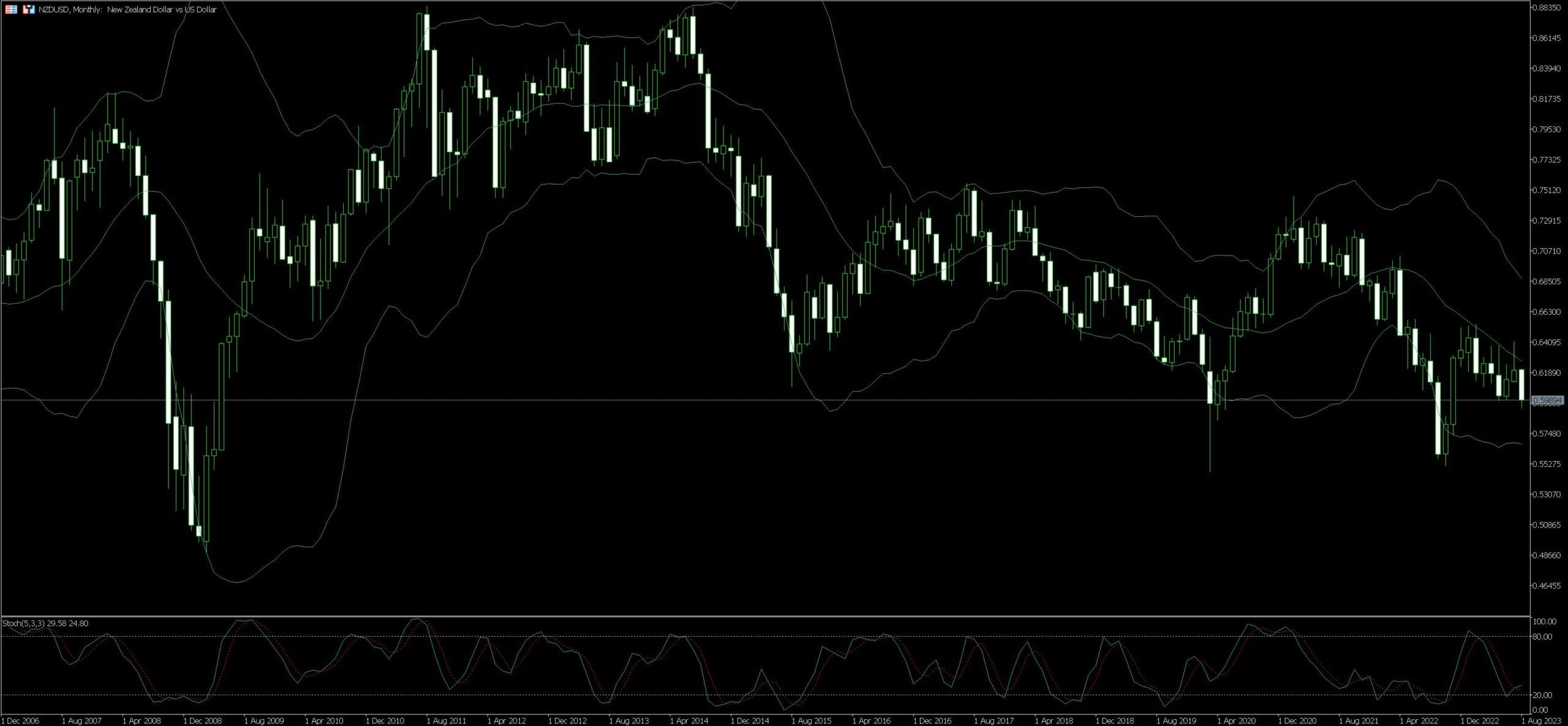Live Chart Of NZD/USD
1. Understanding NZD/USD Trading
In the world of forex trading, understanding the nuances of currency pairs like the NZD/USD is crucial. The NZD/USD pair, also known as the “Kiwi,” represents the New Zealand Dollar against the United States Dollar. Staying updated with the economic health of both these nations is imperative as it can impact the value of their respective currencies.
The New Zealand Dollar (NZD) is heavily influenced by commodity trading, including dairy products and raw materials. Therefore, any shift in commodity prices can affect the NZD’s value. Additionally, factors such as GDP, unemployment rates, and inflation in New Zealand can impact this currency.
On the other hand, the United States Dollar (USD) plays a significant role in global economics. Factors like Federal Reserve policies, US employment rates, and geopolitical tensions can influence its value.
When trading NZD/USD, traders need to monitor economic indicators from both countries. For instance, if New Zealand’s economy is doing well and commodity prices are rising, the NZD value may increase against the USD. Conversely, if the US economy experiences turmoil or the Federal Reserve shifts its policies, it could devalue the USD, causing an upsurge in the NZD/USD pair.
Another essential aspect of trading NZD/USD is understanding its volatility. NZD/USD is less liquid compared to other major currency pairs, leading to higher volatility, which could be both profitable and risky for traders. Thus, a well-researched strategy and appropriate risk management techniques need to be employed while trading NZD/USD.
Timing is another key aspect when trading this pair. The highest levels of volatility and liquidity are generally experienced during the overlap of the New York and London market sessions, providing potential opportunities for traders.
In conclusion, understanding and effectively trading the NZD/USD pair requires a comprehensive knowledge of the economic indicators for both countries, awareness of the pair’s volatility, and strategic timing of trades.

1.1. Fundamentals of Currencies
Understanding the fundamentals of trading currencies, particularly the NZD/USD pair, starts with recognizing the forces that influence each currency’s value. The New Zealand Dollar (NZD) often responds to changes in commodity prices, the nation’s major economic indicators, and the central bank’s policy decisions. The U.S Dollar (USD), on the other hand, relies heavily on economic activity across the globe as it’s considered a global reserve currency.
Commodity prices play an integral part in NZD valuation. As a significant exporter of goods like dairy products and lumber, swings in global commodity prices can impact NZD trading. Sharp rises in these prices often lead to an appreciating NZD, due to potential increases in New Zealand’s revenues from exports.
New Zealand’s economic indicators are also pivotal. Factors such as GDP growth, inflation rates, and employment figures can signal the health of the New Zealand economy, influencing NZD value. Positive data typically boost NZD’s strength, whereas negative figures can trigger a decline.
Central bank decisions are another key force. The Reserve Bank of New Zealand’s (RBNZ) monetary policy moves like interest rate changes or quantitative easing measures ripple through the market. Higher interest rates could attract foreign investment, bolstering NZD. Conversely, cuts or other easing measures could result in a weaker NZD.
Turning to the USD, because the U.S is the world’s largest economy, the economic health of its major trading partners can affect USD strength. Global economic or geopolitical events can also bring about fluctuations in USD value, given its status as a safe-haven asset.
U.S. economic data is also vital to USD, with jobs reports, GDP figures, and Federal Reserve policy announcements among the significant factors. These variables can influence trader sentiment about the health of the U.S. economy and the future direction of the Federal Reserve’s monetary policy, which in turn guides USD’s trajectory in the forex market.
With these basic facts at hand, successful trading of the NZD/USD currency pair is well within reach. Pay close attention to these indicators, act prudently and the potential for lucrative trades opens up.
1.2. Influence of Economic Factors
In the world of foreign exchange trading, understanding the impact of economic factors is key. Pivotal to this is grasping the dynamic elements that directly influence the New Zealand Dollar and US Dollar. The strength or weakness of the NZD/USD pair can be largely attributed to these economic aspects.
Inflation rates wield considerable sway, with higher inflation typically depreciating a country’s currency. For instance, when New Zealand’s inflation rate surpasses that of the US, the NZD tends to weaken against the USD, and vice versa.
Also of importance are interest rates, as these can significantly sway investor sentiment and adjustments in rates can cause a ripple effect. Higher interest rates often attract foreign investors, bolstering the currency. To illustrate, if the Reserve Bank of New Zealand raises interest rates while the US Federal Reserve maintains or even lowers theirs, the NZD could gain against the USD.
Another noteworthy variable is the broad economic performance presented through Gross Domestic Product (GDP). Strong GDP growth in New Zealand coupled with stagnant or falling GDP in the US could lead to a stronger NZD relative to the USD.
Lastly, not to be ignored is geopolitical stability. Currency values can fluctuate based on socio-political events. Noteworthy volatile episodes to monitor include elections, wars, and national disasters. These factors can impact the NZD/USD pair, sometimes even causing significant spikes or falls within minutes.
Trade balance, a measure of the difference between a country’s imports and exports, also plays a critical role. A positive trade balance (surplus) strengthens a currency, while a negative one (deficit) weakens it. For example, if New Zealand exports more than it imports, leading to a trade surplus, the NZD typically appreciates against the USD.
In the journey of forex trading, understanding these economic indicators and their potential effect on currency pairs like NZD/USD is crucial. Success hinges on adeptly navigating these ever-shifting tides.
2. Successful Strategies for NZD/USD Trading

Embracing knowledge of economic indicators, such as the Consumer Price Index (CPI), Gross Domestic Product (GDP), and Trade Balance is fundamental. These indicators directly impact the NZD/USD trading pair as they reflect New Zealand’s economic health and consumer confidence. When these statistics reveal fortitude or augmentation in the NZ economy, the NZD tends to strengthen against the USD.
Familiarity with technical analysis and the utilisation of trend lines, support and resistance levels, and various technical indicators (MACD, RSI, etc.) bestow traders an edge in deciding entry and exit points. Evaluating these instruments assists in identifying price trends for the NZD/USD trading pair.
In the realm of NZD/USD trading, interest rate differentials between the Reserve Bank of New Zealand and the Federal Reserve in the US play a crucial role. A higher interest rate in New Zealand compared to the US generally leads traders towards the NZD, boosting its value.
Applying the carry trade strategy effectively involves selling a currency with a low-interest rate and using the funds to buy a currency yielding a higher interest rate. For NZD/USD, adopting this strategy means buying the NZD if it has a higher interest rate and selling the USD if it has a lower rate.
Adherence to risk management practices ensures steadfastness on the turbulent sea of foreign exchange trading. Utilising stop-loss orders, maintaining an appropriate risk/reward ratio, and never risking more than a small percentage of trading capital on a single trade are paramount principles in NZD/USD trading.
2.1. Utilising Technical Analysis
Technical analysis is a crucial tool that can significantly enhance your trading decisions for the NZD/USD pair. This analytical approach relies on past market data to predict future price movements, with charts being its primary staple.
Delving deeper into technical analysis, trend lines, candlestick patterns, and levels of support and resistance are substantial elements to pay heed to. The inception of a new trend might lead to considerable price movements while consolidating trends could hint that the NZD/USD is due to break out. Candlestick patterns such as doji, engulfing, and hammers can often signal a potential price reversal.
Another integral part of technical analysis is the use of indicators. Different market conditions might call for varying instruments, so understanding these is a must. Take for instance, Moving Averages and Bollinger Bands can help identify the underlying trend and the RSI or Stochastic oscillator can indicate overbought or oversold conditions.
In addition to these tools, Fibonacci retracement levels can provide potential support and resistance zones. Also, consider the bigger picture by analyzing higher time frames, which often offer the most dependable signals.
Executing successful trades hinges on combining multiple elements of technical analysis. Yet, remember not to overcomplicate your charts, as this could cloud your judgment. Include only the necessary tools, and remember that sometimes, simple is better in trading.
While technical analysis caters significantly towards your NZD/USD trading decisions, don’t disregard the impact of macroeconomic events and news. These occurrences can cause unexpected price fluctuations, making it vital to incorporate this factor into your trading plan. Though, sticking to a particular plan and applying technical analysis consistently can often be the key to long-term trading success.
Be sure to practice this method in a demo account first to become familiar with different technical analysis tools before applying them to your live NZD/USD trades. It’s crucial to gain a deep understanding and experience with the tools to harness their potential completely.
Technical analysis indeed forms a significant part of your NZD/USD trading toolkit, but a well-rounded trading strategy should also include fundamental analysis, risk management, and psychological aspects.
2.2. Incorporating Fundamental Analysis
Incorporating fundamental analysis into trading strategies is a game-changer in the dynamic Forex market, especially in trading notable pairs like NZD/USD. Fundamental analysis scrutinizes numerous economic indicators and socio-political events that may affect currency values.
Heavy consideration is placed on indicators such as interest rates, inflation rates, GDP, employment statistics, among others. For instance, an interest rate hike by the Reserve Bank of New Zealand can result in the appreciation of the NZD due to the prospective return on deposits that may attract investors.
Political stability also significantly impacts currency values. Policies and events, either domestic or international, can steer sentiment and speculation in the market, subsequently affecting demand and supply. An example would be the impact of U.S. election results or the U.S.-China trade war on the NZD/USD pair.
Understanding and evaluating the likely impact of these factors are key in fundamental analysis. It enables traders to anticipate market trends and make strategic decisions. Thus, a fundamental understanding doesn’t just equip a trader with the capability to make informed decisions; it paints a bigger picture, allowing the trader to weave in and out of market curves with a level of predictability.
2.3. Risk Management in NZD/USD trading
Venturing into NZD/USD trading requires an astute understanding of risk management. An integral part of trading any currency pair, it is crucial for ensuring that potential losses are kept within acceptable limits.
Utilizing strategies such as stop-loss orders permits the trader to define the degree of risk they’re willing to take. This order will automatically trigger a sell once the currency pair hits a predetermined low, limiting the potential monetary damage. However, caution must be applied as hastily placed stop-loss orders can lead to premature exiting from what might be a profitable position.
Moreover, position sizing is key. Allocating only a small portion of the trading portfolio to any one currency pair, such as NZD/USD, can help to balance the risk. Through diversifying, any losses in one area can be offset by potential gains in another.
An understanding of leverage is also central to risk management in NZD/USD trading. While leveraging can magnify potential profits, it can equally enlarge losses. Knowledge of how to employ leverage judiciously can be the difference between a profitable trade and a damaging loss.
Equally imperative is keeping up-to-date with factors that influence the NZD/USD currency pair. From economic indicators to political events, staying informed will help with making educated trade decisions. Trading with the trend and not against it, another cardinal edict of risk management, is easier when you’re on top of current affairs.
Lastly, never underestimate the power of a well-researched trading plan. Chart out objectives, strategies, and tactics to stick to. Having a plan curbs the possibility of panic-based or impulsive decisions, thus mitigating risk. In this way, a trader is less likely to make an unwarranted or risky trade. Keeping emotions in check and making rational decisions in lieu of sudden emotional responses ensures a more successful and controlled NZD/USD trading experience.
Every strategy in risk management serves its purpose to keep the trading venture in control, helping traders to avoid losses that could potentially wipe out their investments. Even though NZD/USD trading requires knowledge and skill, the role of effective risk management in it is undeniable.
3. Tips for NZD/USD Trading

Understand the basics. Maintain a keen eye on the economic factors influencing the NZD/USD pair. The New Zealand economy relies heavily on dairy exports and tourism, impacting the NZD. Simultaneously, the USD is highly influenced by the US Federal Reserve’s monetary policies and the state of the world economy, as it’s a globally accepted currency.
Utilize Economic Calendars. Economic calendars are indispensable tools for NZD/USD trading. Use these calendars to track critical economic news and announcements that could impact the value of NZD or USD. High impact news like changes in interest rates, GDP reports or unemployment rates can cause significant fluctuations in this pair exchange rate.
Familiarize with Time Zones. The distinct geographical locations of New Zealand and the US mean that their financial markets operate in different time zones. The NZD/USD is mostly active when either of these markets is open. Consequently, traders need to be aware that the busiest trading hours for NZD/USD are during the New Zealand working hours and during the US trading session.
Employ suitable trading strategies. Depending on the trader’s style, several strategies can be useful for NZD/USD trading. For instance, day traders could employ scalping strategies aiming to profit from small price changes. On the other hand, fundamental traders could analyze economic data from both New Zealand and the US to determine long-term trends.
Evaluate Risk Management. NZD/USD trading, like any currency trading, isn’t devoid of risks. Hence, it’s essential to have a risk management plan. It will help bring in discipline and guide the trader on when to enter or exit a trade, size of the positions to be taken and how much risk should be assigned to each.
Stay updated with global geopolitical situations. Traders should be well-informed about the global geopolitical scene since any significant event or crisis can considerably impact the NZD/USD pair. This currency pair being a minor one, can be susceptible to dramatic changes due to significant geopolitical or world economic news.
By adopting these tips, traders can get an advantage while trading this intriguing and potentially lucrative NZD/USD currency pair.
3.1. Timing Trades Appropriately
In trading NZD/USD, the aspect of timing cannot be understated. Recognizing the right moment to enter or exit a trade is paramount. Observe the market for signs of volatility, as these periods often provide the best opportunities. Two key periods stand out as ideal; the American trading session (from 1 pm to 10 pm GMT) when the U.S. market is active, and the Asian trading session (from 10 pm to 7 am GMT), when the New Zealand market is in play.
Analysis of market trends is another crucial aspect of timing your trades. Fundamental factors like GDP, unemployment rates and interest rates often cause shifts in the NZD/USD exchange rate. Stay updated with economic calendars to anticipate these changes. During periods of significant economic announcements, the market tends to become highly volatile providing great trading opportunities.
Placing orders might be challenging due to time zone differences; therefore, using limit orders and stop orders can help in executing trades at desired levels even when not active in the market. A limit order allows traders to purchase or sell a currency pair at a specified price or better, while a stop order executes a trade when a certain price level is reached. This ensures that opportunities are not missed, and potential losses are capped.
Furthermore, the New Zealand dollar exhibits seasonality, often appreciating in the months of December and January. This is largely attributed to tourism and the demand for agricultural commodities during these months. Therefore, being conscious of this cycle may present lucrative trading opportunities.
Lastly, practicing sound money management techniques is vital to sustain long-term profitability. Only risk a small percentage of capital on each trade and have set stop losses to prevent large drawdowns. This approach can certainly mitigate risks and enhance profits.
3.2. Adopting Logical Trader Psychology
Trading NZD/USD efficiently requires an approach that involves not just adopting a suitable trading strategy, but also mastering trader psychology. Logical trader psychology is a crucial element in the equation for regular profits. This means thinking rationally, and not letting emotions influence trading decisions.
A significant part of logical trader psychology concerns risk management. Every trade placed carries its risk, and understanding this is paramount. Successful traders are not those who win each trade, but those who manage their losses effectively. Therefore, a logical trader always adheres to risk management principles, never risking more than a predefined proportion of the trading capital on a single trade.
Discipline and consistency are other pieces of the puzzle. Adhering to a trading plan, irrespective of short-term outcomes, illustrates discipline. Avoiding the temptation to deviate from the plan in pursuit of quick profits or recovery from losses promotes consistency.
Objectivity is another quality inherent in logical trader psychology. Processing and interpreting market data without bias prevents decision-making based on emotions such as fear or greed. This means sticking to the facts, examining trends, support and resistance levels, technical indicators, and other pieces of market information.
Just like in every other profession, continuous learning is pivotal to the trading journey. Markets are dynamic, and techniques or strategies that delivered favourable results yesterday might not do the same tomorrow. So, a logical trader is always learning, adapting and adjusting their strategy according to new market data and changing conditions.
Traders must possess a strong emotional balance to deal with losses that are inevitable in trading. Mental resilience allows a trader to recover from losing streaks, analyze what went wrong, and bounce back stronger.
In the pursuit of trading profitably, developing a logical trader’s mindset is just as important, if not more so, than technical expertise or a brilliant trading strategy. So, it’s imperative to cultivate these characteristics to thrive in the ever-challenging world of forex trading.
3.3. Continual Learning and Adaptation
In the ever-evolving world of Forex trading, continual learning and adaptation form the cornerstone of success. As in the case of trading NZD/USD, traders must keep an open perspective and flexible mindset to navigate the inevitable turmoil of market fluctuations. A rigid approach could lead to missed opportunities or losses under unexpected market conditions.
One cannot stress enough the critical value of revising strategies based on performance. If market dynamics change, a trading strategy that was once successful may need refinement. As the NZD/USD pair is influenced by factors like interest rates, economic data, and geopolitical events, traders must stay abreast with these variables to fine-tune their strategies in real-time.
The dynamism of the Forex market also necessitates a proactive stance towards learning. New technical analysis tools, trading platforms, and risk management techniques emerge continually. Embracing these advancements could provide a distinct edge in NZD/USD trading. With resources ranging from online courses, webinars, trade tutorials, to real-time news feeds, the opportunities to refine trading skills are virtually limitless.
Another aspect that elicits adaptation is the trader’s psychological resilience. The inherent volatility of the NZD/USD pair can provoke strong emotional responses. Successful traders cultivate an ability to manage their emotions, adapt their mindset, and maintain discipline, irrespective of transient market conditions.
In essence, unlocking trading success in NZD/USD necessitates a cyclical process of learning, application, review, and adaptation. This iterative loop enables traders to synergize their strategies with market realities, paving the path towards consistent trading outcomes.










